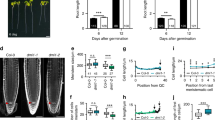Abstract
Calmodulin and NAD kinase were extracted from serial developmental sections of the pea root apex. Highly purified samples of calmodulin were assayed by NAD-kinase activation, and whole-cell extracts were examined by two-dimensional polyacrylamide gel electrophoresis. Calmodulin was found to vary 17-fold in concentration over the apical 2 mm, being high in the region of the root cap and meristem, falling rapidly at the base of the meristem during early stages of rapid cell elongation. The rate of decline was different between stele and cortex. Except for a minor increase in concentration 2.5–5 mm from the apex, which coincides with the region of localised meristematic activity during initiation of lateral root primordia, the concentration of calmodulin remained at the lower level throughout the more basal sections of the apical 10 mm. In-vitro NAD-kinase activity was found to increase 17-fold per cell over the apical 30 mm, almost entirely as the result of an increase in calmodulin-dependent activity. Quantitative estimates of both calmodulin and NAD kinase were found to be highly dependent on extraction procedures.
Similar content being viewed by others
Abbreviations
- EGTA:
-
ethylene glycol-bis (β-aminoethyl ether)-N,N,N′,N′-tetraacetic acid
References
Allan, E.F. (1984) Gene expression during early differentiation in the root apex of Pisum sativum. Ph.D. thesis, Edinburgh, UK
Anderson, J.M., Cormier, M.J. (1978) Calcium-dependent regulator of NAD kinase in higher plants. Biochem. Biophys. Res. Commun. 84, 595–602
Anderson, J.M., Charbonneau, H., Jones, H.P., McCann, R.O., Cormier, M.J. (1980) Characterization of the plant nicotinamide ademine dinucleotide kinase activator protein and its identification as calmodulin. Biochemistry 19, 3113–3120
Burgess, W.H., Jemiolo, D.K., Kretsinger, R.H. (1980) Interaction of calcium and calmodulin in the presence of sodium dodecyl sulphate. Biochim. Biophys. Acta 623, 257–270
Caldwell, C.R., Haug, A. (1981a) Affinity chromatographic isolation of calmodulin from bovine-brain acetone powder. Anal. Biochem. 116, 325–330
Caldwell, C.R., Haug, A. (1981b) Calmodulin stimulation of the barley root plasma membrane bound Ca2+, Mg2+ dependent ATPase. (Abstr.) Plant Physiol. 67, Suppl, 136
Charbonneau, H., Cormier, M.J. (1979) Purification of plant calmodulin by fluphenazine-sepharose affinity chromatography. Biochem. Biophys. Res. Commun. 90, 1039–1047
Cheung, W.Y. (1967) Cyclic 3′, 5′-nucleotide phosphodiesterase. pronounced stimulation by snake venom. Biochem. Biophys. Res. Commun. 29, 478–482
Cheung, W.Y. (1971) Cyclic 3′, 5′-nucleotide phosphodiesterase. Evidence for and properties of a protein activator. J. Biol. Chem. 246, 2859–2869
Cheung, W.Y. (1980) Calmodulin plays a pivotal role in cellular regulation. Science 207, 19–27
Cormier, M.J., Jarrett, H.W., Charbonneau, H. (1982) Role of Ca++-calmodulin in metabolic regulation in plants. In: Calmodulin and intracellular Ca2+ receptors, pp. 125–139, Kakiuchi, S., Hidaka, H., Means, A.R. eds. Plenum Press, New York
Dedman, J.R., Welsh, M.J., Kaetzel, M.A., Purdue, R.L., Brinkley, B.R. (1982) Localisation of calmodulin in tissue culture cells. In: Calcium and cell function, vol. III, pp. 455–472, Cheung, W.Y. ed. Academic Press, New York London
Fowler, M.W., ap Rees, T. (1970) Carbohydrate oxidation during differentiation in roots of Pisum sativum. Biochim. Biophys. Acta 201, 33–44
Gibbs, M., Beevers, H. (1975) Glucose dissimilation in the higher plant. Effect of age of tissue. Plant Physiol. 30, 343–347
Grand, R.J.A., Nairn, A.L., Perry, S.V. (1980) The preparation of calmodulins from barley (Hordeum sp.) and Basidiomycete fungi. Biochem. J. 185, 755–760
Jarrett, H.W., Brown, C.J., Black, C.C., Cormier, M.J. (1982) Evidence that calmodulin is in the chloroplast of peas and serves a regulatory role in photosynthesis. J. Biol. Chem. 257, 13795–13804
Klee, C.B., Crouch, T.H., Krinks, M.H. (1979) Calcineurin: a calcium- and calmodulin-binding protein of the nervous system. Proc. Natl. Acad. Sci. USA 76, 6270–6273
Klee, C.B., Crouch, T.H., Richman, P.G. (1980) Calmodulin. Annu. Rev. Biochem. 49, 489–515
Laemmli, U.K. (1970) Cleavage of structural proteins during the assembly of the head of bacteriophage T4. Nature 227, 680–685
Muto, S., Miyachi, S. (1977) Properties of a protein activator of NAD kinase from plants. Plant Physiol. 59, 55–60
Muto, S., Miyachi, S. (1984) Production of antibody against spinach calmodulin and its application to radioimmunoassay for plant calmodulin. Z. Pflanzenphysiol. 114, 421–431
O'Farrell, P.H. (1975) High resolution two-dimensional electrophoresis of proteins. J. Biol. Chem. 250, 4007–4021
O'Farrell, P.Z., Goodman, H.M., O'Farrell, P.H. (1977) High resolution two-dimensional electrophoresis of basic as well as acidic proteins. Cell 12, 1133–1141
Roux, S.J., Slocum, R.D. (1982) Role of calcium in mediating cellular functions improtant for growth and development in higher plants. In: Calcium and cell function, vol. III, pp. 409–453, Cheung, W.Y., ed. Academic Press, New York London
Schleicher, M., Zendegui, J.G., Watterson, D.M. (1982) Purification of calmodulin-like proteins from an unicellular alga and two higher plants. (Abstr. 1362) Fed. Proc. 41, 503
Sutcliffe, J.F., Sexton, R.F. (1974) Enzymatic changes during the differentiation of tissues in young pea roots. In: Structure and function of primary root tissues, pp. 203–219, Kolek, J. ed. Veda, Bratislava
Switzer, R.C., Merril, C.R., Shifrin, S. (1979) A highly sensitive silver stain for detecting proteins and peptides in polyacrylamide gels. Anal. Biochem. 98, 231–237
Van Eldik, L.J., Grossman, A.R., Iverson, D.B., Watterson, D.M. (1980a) Isolation and characterisation of calmodulin from spinach leaves and in vitro translation mixtures. Proc. Natl. Acad. Sci. USA 77, 1912–1916
Van Eldik, L.J., Piperno, G., Watterson, D.M. (1980b) Comparative biochemistry of calmodulins and calmodulin-like proteins. Ann. N.Y. Acad. Sci. 356, 36–42
Yamamoto, Y. (1963) Pyridine nucleotide content in the higher plant. Effect of age of tissue. Plant Physiol. 38, 45–54
Author information
Authors and Affiliations
Rights and permissions
About this article
Cite this article
Allan, E., Trewavas, A. Quantitative changes in calmodulin and NAD kinase during early cell development in the root apex of Pisum sativum L.. Planta 165, 493–501 (1985). https://doi.org/10.1007/BF00398094
Received:
Accepted:
Issue Date:
DOI: https://doi.org/10.1007/BF00398094




